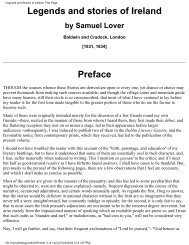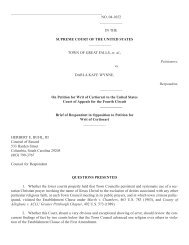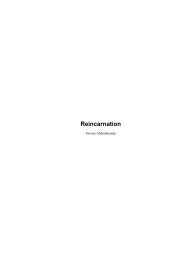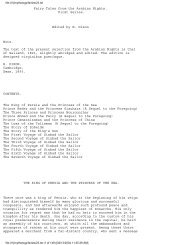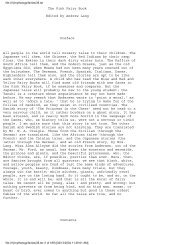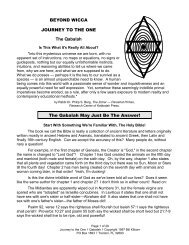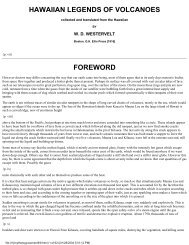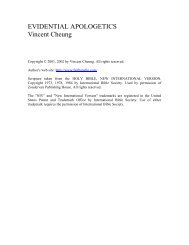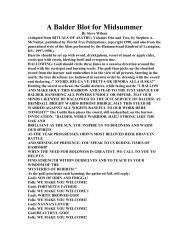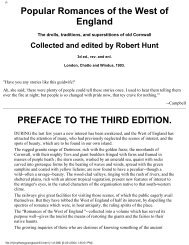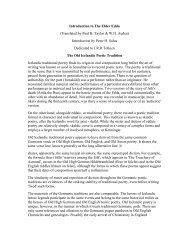Create successful ePaper yourself
Turn your PDF publications into a flip-book with our unique Google optimized e-Paper software.
dynasties, it has been declared that the religion as well as the art of the first Theban empire are nothing<br />
but a slavish copy of those of northern Egypt.[2]<br />
The Theban version.<br />
The Theban version, which was much used in Upper Egypt from the XVIIIth to the XXth dynasty, was<br />
commonly written on papyri in the hieroglyphic character. The text is written in black ink in<br />
perpendicular rows of hieroglyphics, which are separated from each other by black lines; the titles of the<br />
chapters or sections, and certain parts of the chapters and the rubrics belonging thereto, are written in red<br />
ink. A steady development in the illumination of the vignettes is observable in the papyri of this period.<br />
At the beginning of the XVIIIth dynasty the vignettes are in black outline, but we see from the papyrus of<br />
Hunefer (Brit. Mus. No. 9901), who was an overseer of cattle of Seti I., king of Egypt about B.C. 1370,<br />
that the vignettes are painted in reds, greens, yellows, white, and other colours, and that the whole of the<br />
text and<br />
[1. The importance of Annu and its gods in the VIth dynasty is well indicated by a prayer from the pyramid of Pepi II. (for<br />
the texts see Maspero, Recueil, t. x., p. 8, and t. xii., p. 146), which reads:<br />
"Hail, ye great nine gods who dwell in Annu, grant ye that Pepi may flourish, and grant ye that this pyramid of Pepi, this<br />
building built for eternity, may flourish, even as the name of the god Tmu, the chief of the great company of the nine gods,<br />
doth flourish. If the name of Shu, the lord of the celestial shrine in Annu flourisheth, then Pepi shall flourish, and this his<br />
pyramid shall flourish, and this his work shall endure to all eternity. If the name of Tefnut, the lady of the terrestrial shrine<br />
in Annu endureth, the name of Pepi shall endure, and this pyramid shall endure to all eternity. If the name of Seb . . . . .<br />
flourisheth the name of Pepi shall flourish, and this pyramid shall flourish, and this his work shall endure to all eternity. If<br />
the name of Nut flourisheth in the temple of Shenth in Annu, the name of Pepi shall flourish, and this pyramid shall<br />
flourish, and this his work shall endure to all eternity. If the name of Osiris flourisheth in This, the name of Pepi shall<br />
flourish, and this pyramid shall flourish, and this his work shall endure to all eternity. If the name of Osiris Khent-Amenta<br />
flourisheth, the name of Pepi shall flourish, and this pyramid shall flourish, and this his work shall endure to all eternity. If<br />
the name of Set flourisheth in Nubt, the name of Pepi shall flourish, and this pyramid shall flourish, and this his work shall<br />
endure to all eternity."<br />
2. Maspero, la Religion Égyptienne d'après les Pyramides de la VI e et de la VII e dynastie, (In Revue des Religions, t. xii.,<br />
pp. 138, 139.)]<br />
{p. xxix}<br />
Palæography of the version.<br />
vignettes are enclosed in a red and yellow border. Originally the text was the most important part of the<br />
work, and both it and its vignettes were the work of the scribe; gradually, however, the brilliantly<br />
illuminated vignettes were more and more cared for, and when the skill of the scribe failed, the artist was<br />
called in. In many fine papyri of the Theban period it is altar that the whole plan of the vignettes of a<br />
papyrus was set out by artists, who often failed to leave sufficient space for the texts to which they<br />
belonged; in consequence many lines of chapters are often omitted, and the last few lines of some texts<br />
are so much crowded as to be almost illegible. The frequent clerical errors also show that while an artist<br />
of the greatest skill might be employed on the vignettes, the execution of the text was left to an ignorant<br />
or careless scribe. Again, the artist at times arranged his vignettes in wrong order, and it is occasionally<br />
evident that neither artist nor scribe understood the matter upon which he was engaged. According to M.<br />
Maspero[1] the scribes of the VIth dynasty did not understand the texts which they were drafting, and in<br />
the XIXth dynasty the scribe of a papyrus now preserved at Berlin knew or cared so little about the text<br />
which he was copying that he transcribed the LXXVIIth Chapter from the wrong end, and apparently<br />
file:///I|/mythology/egypt/1/1.html (18 of 189) [01/25/2004 3:29:57 PM]



